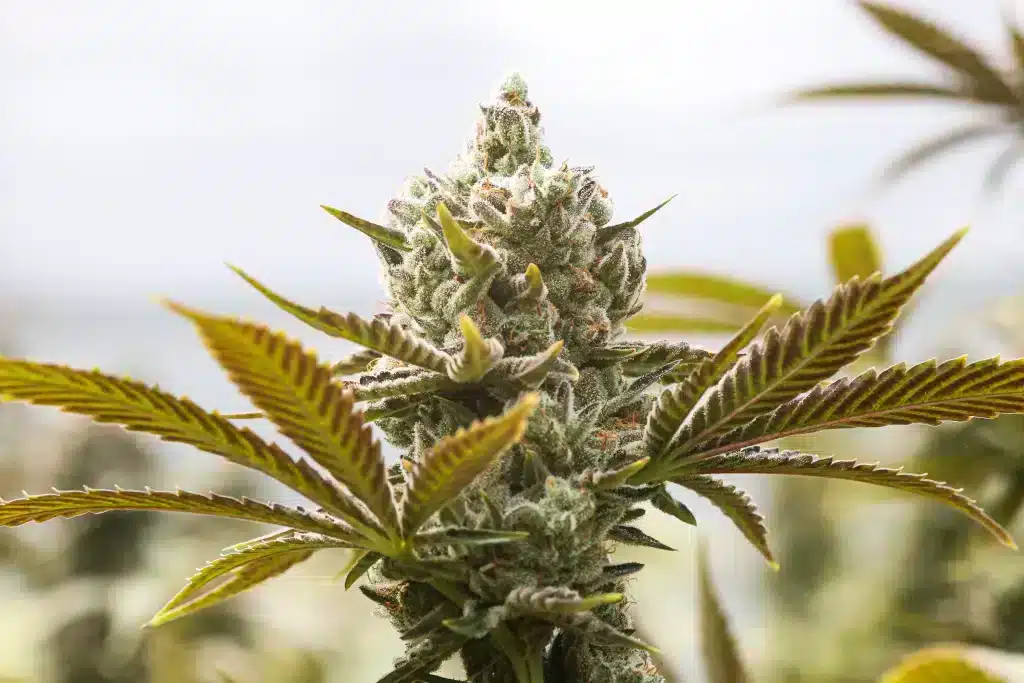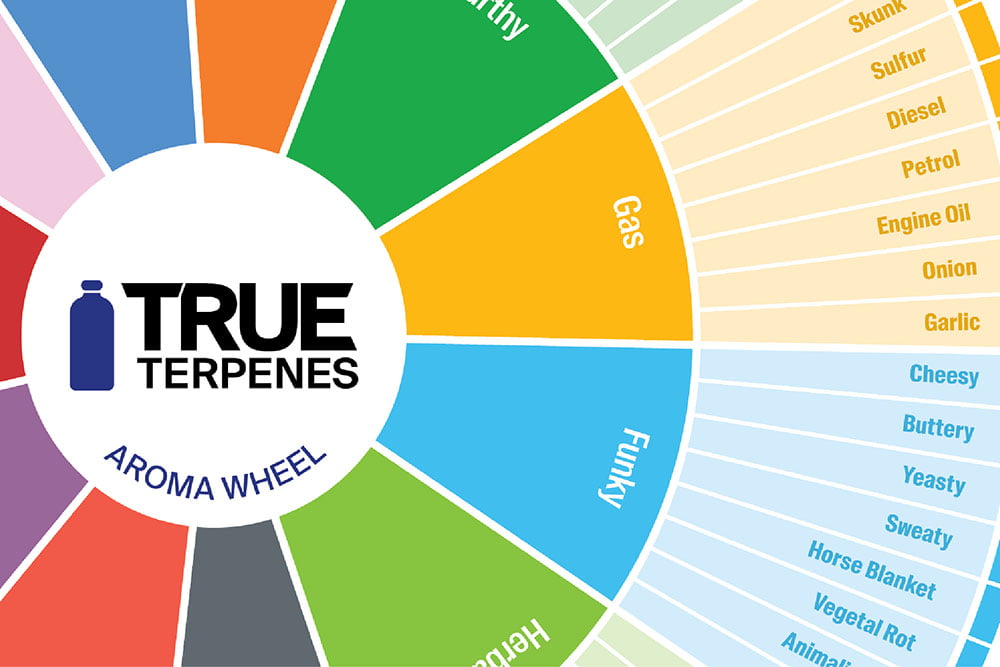June 21, 2023
What Are Cannabis-Derived Terpenes?

If you’ve ever smelled your favorite citrus fruit and immediately recognized its signature aroma, you can thank its terpene strains. To manufacture many of the nutritional, medicinal, and recreational products used today, manufacturers use botanical and cannabis terpenes. Find out more about terps, their benefits, and where to find your favorites with True Terpenes.
What Is the Difference Between Cannabis Terpenes and Cannabinoids?
To understand where terpenes come from, we must first understand trichomes. Best described as sticky, hair-like glands on the plant’s epidermis, trichomes contain cannabinoids, such as tetrahydrocannabinol (THC), cannabidiol (CBD), and cannabinol (CBN), as well as flavonoids and terpenes. While they’re found all over the plant, these microscopic powerhouses primarily develop on the cannabis flower and leaves.
Terpenes (hydrocarbons) play an integral role in cannabis plant health and survival. They enrich leaf and bud aroma and flavor, helping to attract pollinators, deter potentially harmful creatures, and support the plant’s immune system. While they can be found in many different plants, fruits, and vegetables, about 150 different types of terpenes are found in cannabis alone.
In relation to bioactivity, terpenes, and cannabinoids affect the human body in different ways:
- Cannabinoids: These cannabis chemical compounds interact with receptors in the body, creating a chain reaction that produces psychoactive and physiological effects. For instance, this is how THC creates the “high” users experience.
- Cannabis terpenes: A specific terpene’s effect depends on how it’s used. Much smaller molecules than cannabinoids, these compounds activate receptors to produce more therapeutic or medicinal effects.
While they produce different results, terpenes work well with cannabinoids like THC and CBD. Depending on the type, they may be used to enhance positive effects or minimize certain negative ones.
Cannabis-Derived Terpenes (CDT) vs. Botanical-Derived Terpenes (BDT)
Oftentimes in the cannabis space, we’re examining cannabis-derived terpenes, meaning only those found on the cannabis plant. However, these compounds naturally occur in all plants – and even some animals – in the natural world. Botanical-derived terpene (BDT) is a term used to describe the terpenes that come from non-cannabis vegetation.
How Are Terpenes Different from Flavonoids?
The answer to this question lies in your senses. Terpenes and flavonoids are both responsible for signature cannabis aromas and flavors and hold therapeutic value. However, flavonoids primarily contribute to plant pigmentation. So the next time you see a plant in the wild, you can thank its flavonoids for its lush appearance.
What Are Cannabis Terpenes and Their Effects?
Each cannabis strain has its own complex blend of terpenes and cannabinoids. Yet, even the same strains can have slightly different terpene levels. It all depends on how it’s grown and other environmental factors. In terms of therapeutic nuances, a strain that contains an abundance of one terpene could benefit one user more than another. For instance, Blue Dream can help someone combat chronic inflammation because it’s rich in anti-inflammatory terpenes.
What Are the Benefits of Cannabis Terpenes?
The benefits of cannabis-derived terpenes can be broken down into three parts:
- User experience: First and foremost, terps give cannabis products their unique aroma and flavor. Consumers who love citrusy notes may prefer strains high in limonene, whereas others may prefer a spicier profile rich in caryophyllene. The terps in a particular strain play just as great a role in the user experience as it does in personal preference.
- Therapeutic properties: Terps also carry several therapeutic qualities. From mood balancing to relaxation, research has shown that several varieties yield specific benefits.
- Blue Dream: Chronic pain, inflammation, insomnia, PTSD
- Sour Diesel: Fatigue, stress, mental fog, acute pain
- Bubba Kush: Insomnia, nausea, low appetite, acute pain
- Grandaddy Purple: Restless leg syndrome (RLS), insomnia
- LA Confidential: Inflammation, stress, pain
Terpenes in Cannabis
Beyond the sensory experience, cannabis terpenes each have their own unique characteristics. Examples include the following:
Myrcene
Myrcene is characterized by an earthy, fruity aroma. While also found in thyme, lemongrass, and hops, it’s also the most prominent cannabis terpene out there. This compound is known for inflammation and pain relief.
Pinene
As the name suggests, pinene is found in pine needles but also in cannabis. Known for anti-inflammatory and respiratory support, this terpene has helped patients with arthritis, Crohn’s disease, asthma, and other ailments.
Limonene
With its signature citrus aroma, limonene is a highly recognizable terp and it’s likely in your favorite lemon or sour cannabis strain. Limonene is known for antibacterial, antifungal, and anti-anxiety effects.
Caryophyllene
Peppery, spicy notes characterize strains rich in caryophyllene. Along with alleviating depression and anxiety, this terpene may help reduce inflammation in the body.
Linalool
If your strain has the unmistakable notes of lavender or coriander, linalool is likely in the mix. Its many therapeutic properties include anti-inflammatory, anti-anxiety, and immune system support.
Humulene
Humulene is recognizable among beer connoisseurs with its earthy, woody smell. And it’s no surprise – along with marijuana, it’s also found in hops. Among other properties, this terpene provides anti-inflammatory and antibacterial support.
Ocimene
The sweet, citrusy aroma of ocimene is found in common fruits, flowers, and perfumes. While this terpene shows promise in helping patients manage diabetes and hypertension, it also possesses strong anti-inflammatory and anti-oxidative properties.
Terpinolene
Less common across strains is terpinolene, and it features a more complex aroma with pine, floral, and herbaceous notes. It carries antifungal and antibacterial properties. It’s also shown potential in reducing the risk of heart disease and inhibiting cancer cell growth.
Borneol
Woody and slightly bitter, borneol is one of the most beneficial terps, as it’s been used for centuries in Traditional Chinese Medicine (TCM). Borneol has potent anti-inflammatory and analgesic effects.
Geraniol
Detected in low amounts across strains, geraniol has a rosy, fruity smell. This terpene boasts antioxidant, antifungal, antibacterial, and anti-inflammatory benefits. It may also aid patients with cancer, diabetes, and atherosclerosis.
Nerolidol
Also called trans-nerolidol, this terp features notes of citrus, apples, and rose. Research shows nerolidol has antiparasitic, antifungal, antioxidant, antimicrobial, and anticancer properties. It may also have sedative effects.
Camphene
If you imagine you’re standing in the middle of a forest, you’re likely picturing yourself immersed in the earthy, woodsy smell of camphene. Along with reducing cholesterol and triglyceride levels, this terp may help reduce pain, inflammation, and fungal growth.
Terpineol
This term refers to a class with four monoterpenes, each with their own distinct scent: alpha-terpineol, beta-terpineol, gamma-terpineol, and terpinen-4-ol. It’s also common in strains with the more dominant pinene. Terpineol offers relaxation, anti-inflammatory, anti-anxiety, and anti-tumor support. It also has antioxidant properties.
Phellandrene
Also found in eucalyptus, phellandrene is a cannabis terpene with a remarkably minty, citrusy, woodsy smell. It’s known for anticancer and anti-inflammatory support. When combined with limonene, this terp has shown anti-depressant, antihyperalgesic properties.
Carene
Also called delta-3 carene, this terpene lends a citrusy, cypress aroma. It’s used for bone health, anti-inflammatory, and mood-boosting support.
Pulegone
With its sweet, minty aroma, it’s no surprise that this terpene is also found in peppermint. Research shows its potential for helping people with anxiety and cognitive performance.
Sabinene
While only available in small amounts in cannabis, sabinene is also found in Holm oak trees, black, pepper, cardamom, and more. It’s used for its antioxidant and antibacterial properties.
Browsing Cannabis-Terpene Profiles
The next time you’re shopping for your favorite cannabis product, think of the terpene content. Effects depend on the amount of terpene present, as well as type. Sativa, Indica, and hybrid strains to consider for certain conditions include:
The Entourage Effect: Maximizing Your Impact
As scientists have studied terps and the way all the components of the cannabis plant work in harmony, they’ve noticed a phenomenon called the entourage effect. This is the term used to describe the synergy between terpenes and cannabinoids. For instance, some terps can aid in better absorption into the bloodstream or amplify the effects of THC.
Therefore, full-spectrum cannabis used as a whole-plant medicine that contains a combination of cannabinoids, terpenes, and other natural compounds can be more beneficial than taking something like CBD isolate alone.
How Are Terpenes Produced?
Terpenes are sourced from natural plant products and companies work with cannabis growers to create formulations that mimic the chemical signatures of popular cannabis strains. At True Terpenes, ours are extracted using expression, steam, or vacuum distillation methods. Then, these extracted terps are fractionally purified for optimal quality.
Terpene Quality, Safety, and Compliance
Public safety is paramount at our company and we uphold strict regulatory compliance standards for quality assurance. Additionally, terpenes must be handled with care. Undiluted terpenes are highly potent. In most cases, it’s recommended to remain within 1 – 5% concentration by volume.
Find out More About CDT at True Terpenes
At True Terpenes, we specialize in custom terpene blends and consumer education. Our proprietary blends are formulated by our very own Dr. Russo, a board-certified neurologist and pioneering psychopharmacology, cannabinoid and terpenoid researcher. To learn more about CDT, Terpology®, and our products, contact us today.



